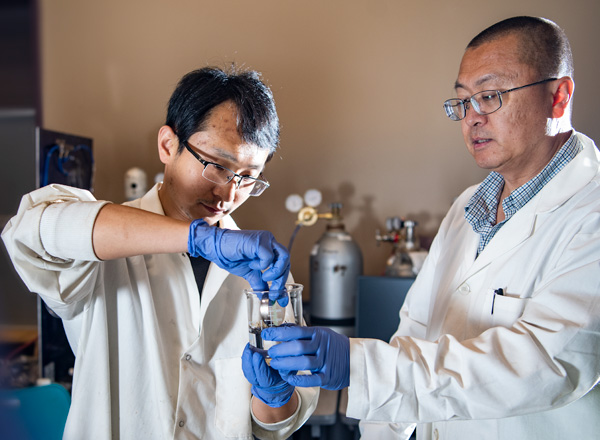|
|
 |
|
UNT artists and scientists collaborate to tackle air quality issues
By exploring how much soot bird feathers accumulate, an interdisciplinary team of faculty and students are working to determine if they can serve as biomonitors of atmospheric pollution. The art-meets-science research project — which includes University Distinguished Research photography professor Dornith Doherty; geography and the environment associate professors Alexandra Ponette-Gonzàlez and Matthew Fry; and biological sciences associate professor Jeff Johnson — has provided prime mentoring opportunities for students. Learn more about the group project — spanning photographing exposed feathers from a freeway location under a scanning electron microscope to capture the deposits of black carbon to visualization of the contaminated feathers through Raku pottery — in which undergraduate research fellows Anna Lee, a senior photography and ceramics major, and Claire Pitre, a geography graduate, played a key role. The team recently presented their findings in the art-and-science exhibition, POLLUMAGE. |
|
|
|
|
|
|
 New licensed technology uses biomass to quickly, cost-effectively clean up toxic spills New licensed technology uses biomass to quickly, cost-effectively clean up toxic spills
Sheldon Shi, professor of mechanical and energy engineering at UNT, has developed a cost-effective way to rapidly clean up spills and contamination in water and other surfaces. By using magnetized activated carbon — or MAC, made from biomass — and a magnetized collection device, the contaminant is quickly absorbed and then removed with magnets. The technology — licensed to EnviroMAC, a startup company formed around commercializing the new method — has the potential to make a tremendous impact on the toxic cleanup industry. |
|
|
|
|
|
| Rediscovering decades-old solution to a modern problem |
UNT's BioDiscovery Institute Research Associate Jaime Barros recently co-authored a paper with Richard Dixon, University Distinguished Research Professor in UNT's College of Science, that was published in the journal Nature Communications. In utilizing state-of-the-art techniques, Barros and the research team resolved a 40-year-old research question explaining how plants produce lignin, a compound that provides structural rigidity in plants and allows them to grow upright, to better understand how to genetically engineer it for use in the biofuel and farming industries. |
|
|
|
|
|
|
| Researcher receives $1 million NSF grant for cardiovascular research |
Dane Crossley, associate professor of biological sciences at UNT, recently received $775,000 of a three-year $1 million grant from the National Science Foundation to continue his research in cardiovascular physiology in reptiles. His project, a collaboration with researchers at the University of North Dakota and California State University at East Bay, examines the effect of developmental hypoxia — low levels of oxygen during fetal development — on juvenile cardiac function. His research is leading to an understanding of the evolution and development of the cardiovascular system and the impacts environmental stress can have on its function. |
|
|
|
|
|
|
| Chasing the elusive Magellanic Woodpecker |
Ph.D. candidate Amy Wynia traveled more than 6,000 miles to Navarino Island in southernmost Chile for 11 months across the span of approximately two years to explore the forests in search of the Magellanic Woodpecker (Campephilus magellanicus), the largest woodpecker in South America. Wynia, a student and researcher in UNT's Sub-Antarctic Biocultural Conservation Program, went to the ends of the earth to collect information for her Ph.D. dissertation and learn more about and try to protect the decreasing population of the birds. |
|
|
|
|
|
|
| Returning to UNT for international research collaboration |
Since working on her doctorate at UNT under Regents Professor of electrical engineering Miguel Acevedo, alumna Shiho Matsubayashi has been interested in the ways technology can help environmental scientists understand the world around them and improve conditions in nature to benefit biodiversity. This June, Matsubayashi, now an associate professor in the Graduate School of Engineering at Osaka University in Japan, returned to UNT to help researchers study the painted bunting, a species of bird native to North Texas, at the Lake Lewisville Environmental Learning Area. |
|
|
|
|
|
|
| Sponsoring entrepreneurship |
UNT at Frisco was the presenting sponsor for CodeLaunch 2019, an annual startup expo and pitch competition, held July 31 at Frisco's Comerica Center. CodeLaunch speakers included finalist nine-year-old Prince Nallamothula and runner-up Gouzia Sivarajah, a high school senior, who have worked closely with mentors at UNT's Inspire Park. The young innovators will be featured speakers at Inspire Frisco's Aug. 14 IFTalk: Rising and Raising Entrepreneurs. Inspire Park serves as a hub for UNT's efforts to empower entrepreneurs of all ages with mentoring, education and networking events. Opened as a business incubator space, Inspire Park now also offers classroom and laboratory space designed to enhance collaborative learning for UNT at Frisco students. |
|
|
|
|
|
|
|
Office of Research and Innovation
University of North Texas
1155 Union Circle #311070
Denton 76203-5017
940-565-2108 |
|
|
|
|
|
| © 2019 UNT Research and Innovation is a publication of the University of North Texas Office of Research and Innovation and the Division of University Relations, Communications and Marketing. Email us at untresearch@unt.edu. |
|
|